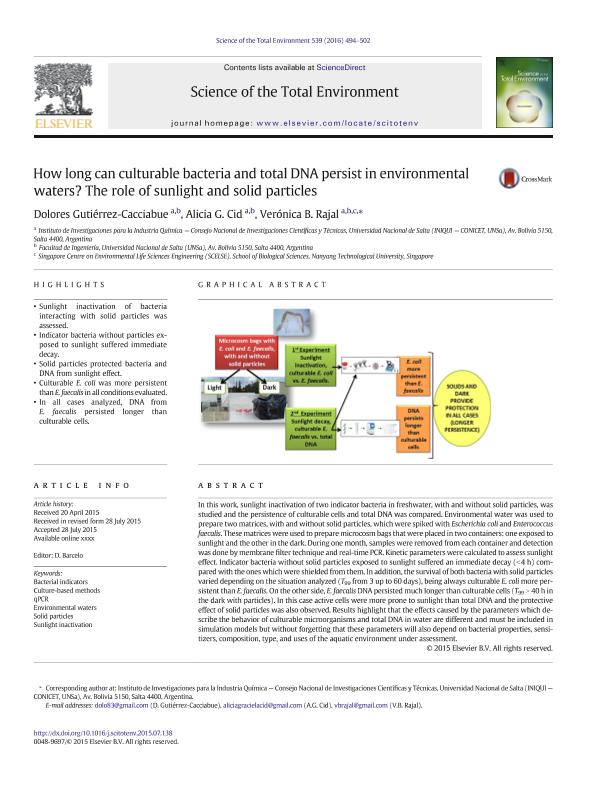Mostrar el registro sencillo del ítem
dc.contributor.author
Gutiérrez Cacciabue, Dolores

dc.contributor.author
Cid, Alicia Graciela

dc.contributor.author
Rajal, Verónica Beatriz

dc.date.available
2018-10-10T20:44:01Z
dc.date.issued
2016-01
dc.identifier.citation
Gutiérrez Cacciabue, Dolores; Cid, Alicia Graciela; Rajal, Verónica Beatriz; How long can culturable bacteria and total DNA persist in environmental waters? The role of sunlight and solid particles; Elsevier Science; Science of the Total Environment; 539; 1-2016; 494-502
dc.identifier.issn
0048-9697
dc.identifier.uri
http://hdl.handle.net/11336/62151
dc.description.abstract
In this work, sunlight inactivation of two indicator bacteria in freshwater, with and without solid particles, was studied and the persistence of culturable cells and total DNA was compared. Environmental water was used to prepare two matrices, with and without solid particles, which were spiked with Escherichia coli and Enterococcus faecalis. These matrices were used to prepare microcosm bags that were placed in two containers: one exposed to sunlight and the other in the dark. During one month, samples were removed from each container and detection was done by membrane filter technique and real-time PCR. Kinetic parameters were calculated to assess sunlight effect. Indicator bacteria without solid particles exposed to sunlight suffered an immediate decay (<4h) compared with the ones which were shielded from them. In addition, the survival of both bacteria with solid particles varied depending on the situation analyzed (T99 from 3 up to 60days), being always culturable E. coli more persistent than E. faecalis. On the other side, E. faecalis DNA persisted much longer than culturable cells (T99>40h in the dark with particles). In this case active cells were more prone to sunlight than total DNA and the protective effect of solid particles was also observed. Results highlight that the effects caused by the parameters which describe the behavior of culturable microorganisms and total DNA in water are different and must be included in simulation models but without forgetting that these parameters will also depend on bacterial properties, sensitizers, composition, type, and uses of the aquatic environment under assessment.
dc.format
application/pdf
dc.language.iso
eng
dc.publisher
Elsevier Science

dc.rights
info:eu-repo/semantics/openAccess
dc.rights.uri
https://creativecommons.org/licenses/by-nc-sa/2.5/ar/
dc.subject
Bacterial Indicators
dc.subject
Culture-Based Methods
dc.subject
Environmental Waters
dc.subject
Qpcr
dc.subject
Solid Particles
dc.subject
Sunlight Inactivation
dc.subject.classification
Ingeniería Medioambiental y Geológica, Geotécnicas

dc.subject.classification
Ingeniería del Medio Ambiente

dc.subject.classification
INGENIERÍAS Y TECNOLOGÍAS

dc.title
How long can culturable bacteria and total DNA persist in environmental waters? The role of sunlight and solid particles
dc.type
info:eu-repo/semantics/article
dc.type
info:ar-repo/semantics/artículo
dc.type
info:eu-repo/semantics/publishedVersion
dc.date.updated
2018-09-27T15:35:54Z
dc.journal.volume
539
dc.journal.pagination
494-502
dc.journal.pais
Países Bajos

dc.journal.ciudad
Amsterdam
dc.description.fil
Fil: Gutiérrez Cacciabue, Dolores. Consejo Nacional de Investigaciones Científicas y Técnicas. Centro Científico Tecnológico Conicet - Salta. Instituto de Investigaciones para la Industria Química. Universidad Nacional de Salta. Facultad de Ingeniería. Instituto de Investigaciones para la Industria Química; Argentina
dc.description.fil
Fil: Cid, Alicia Graciela. Consejo Nacional de Investigaciones Científicas y Técnicas. Centro Científico Tecnológico Conicet - Salta. Instituto de Investigaciones para la Industria Química. Universidad Nacional de Salta. Facultad de Ingeniería. Instituto de Investigaciones para la Industria Química; Argentina
dc.description.fil
Fil: Rajal, Verónica Beatriz. Consejo Nacional de Investigaciones Científicas y Técnicas. Centro Científico Tecnológico Conicet - Salta. Instituto de Investigaciones para la Industria Química. Universidad Nacional de Salta. Facultad de Ingeniería. Instituto de Investigaciones para la Industria Química; Argentina. Nanyang Technological University; Singapur
dc.journal.title
Science of the Total Environment

dc.relation.alternativeid
info:eu-repo/semantics/altIdentifier/doi/https://dx.doi.org/10.1016/j.scitotenv.2015.07.138
dc.relation.alternativeid
info:eu-repo/semantics/altIdentifier/url/https://www.sciencedirect.com/science/article/pii/S0048969715304800
Archivos asociados
